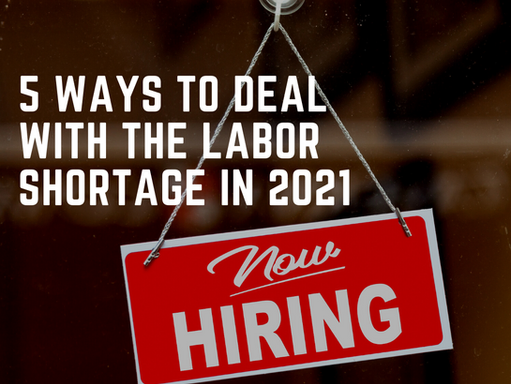Blog

5 Ways to Deal With the Labor Shortage in 2021
The economy in the United States has been in a steady decline in recent years. One of the reasons for this is the labor shortage which has begun to make itself known across the country. Many employers are having difficulty finding workers to hire, and this poses both practical difficulties and economic risks. Employers often worry about not being able to find employees who can do their job well enough; at worst, they worry about losing money due to the lower productivity levels of their current employees. Unfortunately, there doesn’t seem to be a definitive answer as to what will happen next with these workforce shortages. Some have said that technology will solve all of these problems while others say that it’s more or less a myth created by businesses looking for reasons not to hire more people.
Below we will look at 5 ways to deal with the labor shortage in 2021:
1. Automation:
Many employers have chosen this route. The argument here is two-pronged. First, many businesses simply cannot afford to hire more employees due to existing staffing levels. Second, they argue that automating certain aspects of their business
would be beneficial in finding efficiency gains and reducing operating costs. While these arguments hold some weight, they can also be dangerous if not applied correctly. One of the dangers of automation is that it creates a hidden cost associated with it – the human cost – which isn’t accounted for and could eventually hurt profits and growth opportunities rather than help them.
2. Hiring Refugees:
The Federal Government has talked about this possibility. The reality is that the United States will continue to have a labor shortage in 2021, and many employer
s will find it difficult to fill all of their open positions. As a result, the number of refugee immigrants to America will rise during this time. This means that hiring refugees could help alleviate shortages in some areas when more jobs are created in other areas. Of course, the concerns with hiring refugees are two-fold; firstly, there is the possibility that they’ll use their new employment opportunities as an opportunity to gain illegal status in America; secondly, there is also the risk of fake refugees taking advantage of relatively low wages which could hurt local job creation further down the line.
3. Government Investment:
The Federal Government has also been having discussions about investing in training programs to help local businesses find the right candidates for open positions. The federal government has been making plans to allocate more money in these programs which could help provide a source of qualified workers in the private sector. Indeed, this could be a good way to combat some of the concerns with hiring refugees previously mentioned, as it would make it easier for local businesses to fill their open positions from within their own communities instead of from outside.
4. A New Immigration Policy:
Currently, the United States has a strict immigration policy that requires employers to hire American citizens for any job that can’t be filled by a native worker. If more of these language requirements were relaxed, more immigrants from non-English speaking countries could be hired, which would help alleviate some of the shortages across the country. This would also help create a diverse workforce, which is something that many companies have been pushing for anyway.
Obviously, higher wages will affect America’s unemployment rate, but there’s also a case to be made about this being an effective way to deal with labor shortages as well. The problem is that some employers may be more likely to hire workers in an attempt to retain them, which could actually cause more job turnover. If this happens, higher wages will only work at the expense of the business. That said, higher wages could help make some workers’ lives more comfortable, which may incentivize them to stay put instead of constantly looking for better opportunities elsewhere.
These are some of the things that are being discussed today on how businesses can cope with labor shortages in the future. While I don’t know what will happen in 2021, these are five ways that businesses can tackle their labor shortages before they arise.

